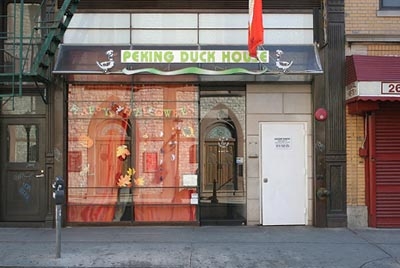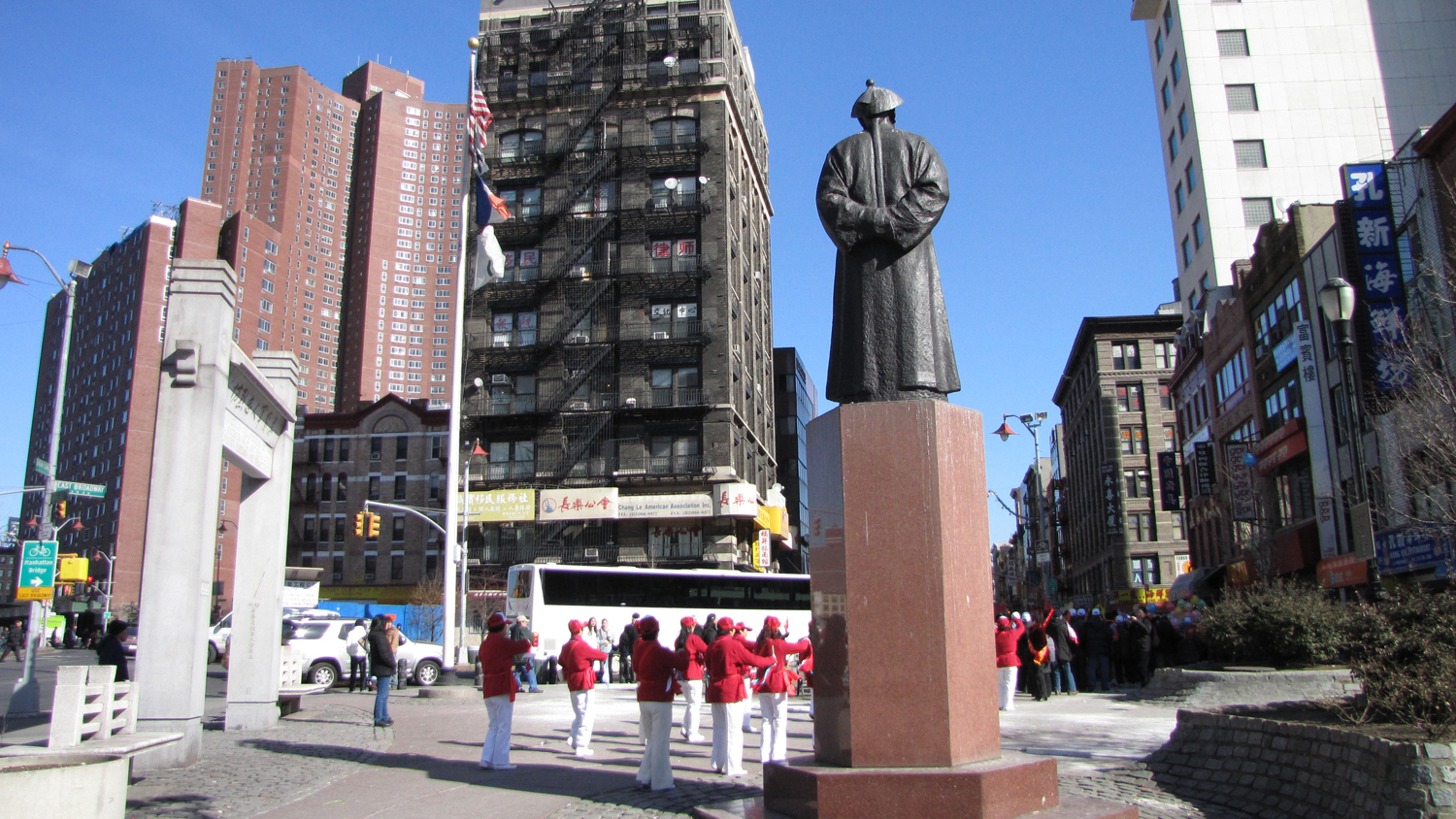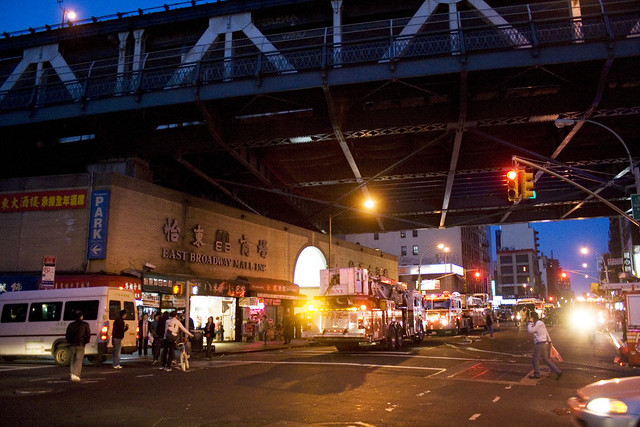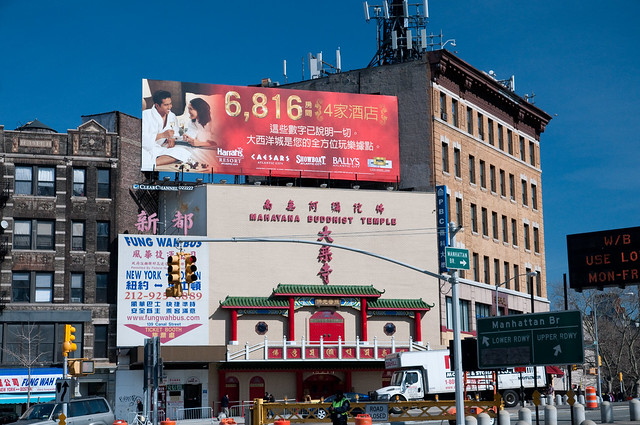Welcome to Chinatown! You can choose to either listen to the whole podcast, or click link by link in any order you prefer.
or
For driving, public transportation, walking, and/or biking routes for this podcast, please click the following link: http://goo.gl/maps/MBM6P
Hello, weary traveler! So you happen to be in Chinatown, and you have no idea what to do next. Have no fear! Just listen carefully to the following podwalk, which will guide you through the busy streets of the historic neighborhood of Chinatown. Your tour begins on the corner of Canal Street and Broadway Street, at the Canal St station on the J, N, Q, R, Z, 4, and 6 subway lines. Remember this location, as it will also be the return site for the tour. This walking tour has a total of nine stops, and will take around forty minutes. Take a deep breath in. Now let it out. You are about to embark on a great journey full of amazing sights, so don’t forget to take a look around as you walk! Enjoy!
loading map - please wait...
| Columbus Park
Columbus Park, Mulberry Street, New York, NY | |
| Chinese Consolidated Benevolent Association Chinese Benevolent Association Podcast As you’re walking to the Chinese Consolidated Benevolent Association on Mulberry Street from Columbus Park, you might want to consider a light snack of $1.25 dumplings from Tasty Dumpling, if you’re feeling hungry. Once you hit Canal St, turn right and take a moment to really take in the environment. Across the street, you may notice small remnants of Little Italy. Canal St. was once a boundary separating the two ethnically distinct neighborhoods. The ever-increasing flow of migrating Chinese have pushed the boundaries of Chinatown and swallowed Little Italy, leaving only a small section a few streets long. Turn onto Mott St, now. In a sense, this street is the Main St. of Chinatown, a microcosm of the tourist attractions. As you walk down the block, an enormous grey building should be on your left side. This is the Chinese Consolidated Benevolent Association building of Chinatown, founded in 1883 and made up of 60 member associations. The building serves as the political nexus of Chinatown, with multiple representatives from the different migrant communities that compose the neighborhood. The president is a figure of considerable importance, serving as the unofficial “Mayor of Chinatown”. The CCBA serves multiple functions, such as : 62 Mott Street, New York, NY | |
Church of Transfiguration Church of the Transfiguration Located on 29 Mott Street, in the heart of Chinatown, stands the Church of the Transfiguration. Since its establishment as a Roman Catholic church in 1853, it has served the religious needs of many immigrant communities in Lower Manhattan. Over the years, the congregation has seen the faces of many Irish and Italians but today it is almost entirely Chinese. The services are held in Cantonese, Mandarin, and English to meet the linguistic needs of all devotees. This church is indeed very sacred to Catholic adherents residing in Chinatown. While it may seem unusual for a catholic church to be in the midst of an enormous Chinese ethnic enclave, Catholicism is surprisingly one of the 5 major religions recognized by the Chinese communist government. Starting in the 18th century, it turns out that missionaries facilitated mass conversions of to Catholicism. The presence of the church in Chinatown gave many potential catholic-Chinese immigrants to the U.S., the confirmation that they would still be able to worship after moving across the world. While the Chinese government recognizes Catholicism, they do not approve of certain catholic traditions such as placing the Pope above state authority. To prevent any sort of opposition, the government has taken strides to alter certain passages in the Chinese-Catholic Bible, forcing the Catholics to print up their own bibles in secret. Many of these people fled China and were welcomed into Lower Manhattan’s Church of the Transfiguration with open arms. The plight of these Chinese-Catholic-Americans was not easy but having the church available made the transition to a new life much easier. As you continue on your journey throughout Chinatown, you will probably be entranced by the zesty aroma of roasting duck that is freshly glazed with a sweet yet tangy Duck Sauce. This is the perfect opportunity to cross the street and enjoy a savory meal at the world-famous Peking Duck House. 29 Mott Street, New York City, NY | |
| Peking Duck House
Walking around Chinatown can be a bit of a workout and can you leave you feeling rather famished. Look no further than Chinatown’s very own Peking Duck House, located at 28 Mott St. After being in business for more than twenty years, the Duck House underwent renovations in 2004, trying to attain a more “modern” setting. Upon stepping through the front door, you will be delighted by the combined arrangements of floral, textiles and lighting. Ambient lighting in the back dresses the main floor, while a softer single light hung above the side tables are meant for the more intimate dinners. As the name implies, the Peking Duck is well known for their famous Peking duck dish. Their house special is quite bountiful and is best enjoyed shared among friends and family. They also offer a repertoire of Hong Kong style cuisine, which has been time tested for popularity and best tasting. Whether its rice platters, noodles or soups topped with roast pork, duck, wontons, or a variety of other dumplings and delicacies, Peking Duck House has got it! So if you’re in the neighborhood and are on a family outing, then Peking Duck House is the place for you! 28 Mott Street, New York, NY | |
| First Shearith Israel Graveyard Congregation Sharith Israel Cemetary Podcast When you are finished with your delicious Chinese cuisine, head down Mott street toward Mosco street. Keep walking on Mott street and then continue on to Oliver street untill you reach St. James Place. Turn right on St. James Place and you will reach a small plot of land which is the First Shearith Israel Cemetery. In 1654, 23 Jews who came from Racife, Brazil held Rosh Hashana (the Jewish new year) services which began the formation of Congregation Shearith Israel, the only Jewish Congregation in New York City until 1825. These early Sephardic Jewish settlers played a big role in the promotion of cultural diversity and religious tolerance in New Netherland and the development of New York City. One big achievement of these early Jewish immigrants was when they received permission to buy a small plot of land for burial purposes in 1656. Sadly, the exact location of this first burial place got lost over the years and is now unknown. The Congregation’s second cemetery whcih you see before you was purchased in 1682 and is the oldest surviving Jewish graveyard in the country. About 100 headstones can still be seen in what remains of the site, the oldest tombstone dating from 1683. The Congregation Shearith Israel continues to maintain the cemetery to this day and holds an annual Memorial Day ceremony at this site in honor of the Revolutionary War veterans that are buried here. This site is landmarked and listed on the State and National Register’s of Historic Places. Nominator Pat De Angelis wrote “this place matters…because it has endured, and because it is a remnant of the past that has quietly been respected by the many ethnic groups that have lived in this busy part of downtown.” In this way, this Cemetery represents the beginning of the rich cultural diversity that can be found in New York City today. 57 St James Pl, New York City, NY | |
| Chatham Square
Chatham Square Podcast Head north on St James Place and make a left at Oliver Street. When you reach a huge plaza with a small park just to your right, you’re in Chatham Square. This is perhaps one of the largest and busiest intersections in the city. At this very junction a total of seven streets intersect: St. James Place, Oliver Street, Bowery Street , East Broadway, Mott Street, Worth Street, and Park Row. Just by looking around you can see how crowded the square is with both people and cars. Before becoming the commercial center it is today, Chatham Square used to be an open air market that sold horses. Then, in 1820, it became the center for saloons, flophouses, and tattoo parlors. Following Prohibition and the Great Depression, Chatham Square finally became what it is today: a memorial. In the center of Chatham Square sits Kimlau Square, within which you can see the statue of Lin Zexu and the Kimlau Memorial Arch, which reads “In Memory of the Americans of Chinese Ancestry who lost their lives in defense of freedom and democracy." If you go up to the statue of Lin Zexu, you’ll find a plaque thats says “Pioneer in the War Against Drugs.” Lin Zexu is considered a national hero in China because of his strong campaign against the British export of opium into China. Opium had been used in China for medicinal purposes for a very long time, but in the year 1825 the British began to export opium to China because they wanted their imports from and exports to China to be balanced. The Chinese soon became addicted to the drug. Although the emperor of China outlawed opium, an illegal trade was soon created. Lin Zexu was responsible for the arrest of 1,700 opium dealers and the destruction of 2.6 million pounds of opium in China. He led what could be thought of as the Chinese equivalent of the Boston Tea Party from June 3 to June 26 when he and 500 workers destroyed opium by throwing it into the sea. Today, June 3 is celebrated as Anti-Smoking Day, while June 26 is the International Day against Drug Abuse and Illicit Trafficking. Chatham Square, New York, NY | |
| East Broadway Mall Inc
East Broadway Mall The next stop will be the East Broadway Mall. From Chatham Square, head east down East Broadway for a few minutes. Feel free to stop along the way to grab a snack at one of the many interesting markets or restaurants. Notice on your walk that East Broadway is less touristy than the other streets you have been walking down. Keep walking down east broadway until you see the manhattan bridge. The mall is actually right under the manhattan bridge on the left side of the street. The East Broadway Mall is located on the corner of East Broadway and Forsyth Street under the Manhattan Bridge. Albeit an unlikely location for a mall, the building built right into the foundation of the bridge is bustling with residents of Chinatown shopping for anything they could possibly need. The East Broadway Mall has an authentic feeling, as it is not a tourist destination as many spots in Chinatown are. The mall contains clothing stores, tailors, restaurants, stores to buy herbs and spices, employment agencies, banks, and places to send money home and buy calling cards. The variety of stores makes it a “one stop shop” for new immigrants, as they can find everything they need in a mall similar to the malls that they were used to seeing in their home country. When the mall was first opened, it was owned and operated by Cantonese immigrants, but due to the influx of immigrants from Fuzhou, it slowly became a gathering place for the Fuzhou community. Fuzhou stores began to take over the Cantonese stores and the mall was eventually sold to Fuzhou owners. It is still owned and operated by the Fuzhou, as Fuzhou immigrants dominate the area surrounding the mall. With its location on East Broadway, the mall is a prime location for Fuzhou residents of Chinatown to meet with friends and run all their errands in one place. The mall is extremely beneficial to new immigrants who are still finding their bearings in New York, as it has everything they could need in one place and all the stores are in their native language. 88 E Broadway, Manhattan, NY | |
| A&N Employment Agency Directions to Employment Agency As you walk around Chinatown, you may see some very small storefronts flooded with people. It is highly probable that one of these storefronts may actually be an employment agency. As we have already stated, Chinatown is the epicenter of the ‘migration industry,’ where it continues to function as an incredibly dynamic immigrant gateway into the United States. Immigrants new and old search for various means of livelihood via these employment agencies. A Fuzhounese immigrant for instance may come to an employment agency and scan the wall in front of the counter for suitable job descriptions. These jobs may range from being a chef in a restaurant in Arkansas to being a busboy in New York. Once he finds a decent-sounding job, interviews are conducted over the phone where details of the job such as salaries and hours are negotiated. The agency would get paid a “head hunting fee,” and the immigrant would leave for wherever they have to go that night by bus. After several weeks of working, a typical Fuzhounese migrant worker may return to Chinatown in search for more work. Most of the time the reason is that the boss is unfair or cheats their employees or the co workers aren't exactly the best people in the world. They come back to Chinatown, wire some money back home, float around the neighborhood, and when they need to earn some money, start the cycle all over again. 1 Eldridge Street, New York, NY | |
| Mahayana Buddhist Temple
Mahayana Buddhist Temple Podcast When you walk north on Bowery, turn right on Canal Street and walk towards what may be the largest Buddhist temple in all of Chinatown. Situated across from the Manhattan Bridge, the temple serves as a colorful religious sanctuary for all, especially for the Mahayana Buddhists who flock to its quarters for prayers. Guarded by massive gilded lions, the temple features a 16-foot tall statue of Buddha, believed to be the largest in the city, surrounded by colorful paintings of bodhisattvas, or Buddhist saints. What I found surprising when visiting the temple was the fact that it was open to the public for free: in fact, for a dollar donation (which I think is entirely voluntary), you can pick out your own fortune from a sea of rolled-up pieces of paper. The temple reminds me of almost any other Buddhist temple found in Chinatown: the smell of burning incense pervades the room. Candles and strips of papers bearing the names of deceased loved ones line the walls. At the foot of the Buddha, devotees have placed round yellow and red fruits to signify perfection, joy, and good fortune. It’s interesting to note that Mahayana Buddhism, along with Taoism, is one of the mainstream religions practiced in the Fujian Province in China. This just goes to show that as the latest immigrant wave from China, the Fuzhounese brought their religion, among countless other customs, social practices, and belief systems to the “Land of Opportunity.” 133 Canal Street, New York, NY |
Conclusion for Chinatown Podcast
Additional Resources:
1. “Explore Chinatown Nyc – Home.” Explore Chinatown Nyc – Home. N.p., n.d. Web. 14 May
2013. <http://www.explorechinatown.com/>.
2. “New York City Walking Tour: A Taste of Chinatown.” Fodor’s. N.p., n.d. Web. 14 May
2013. <http://www.fodors.com/news/story_5396.html>.
3. Gray, Michael. “NYC Chinatown Tours.” Nycchinatowntours. Michael Gray, n.d. Web. 14
May 2013.
4. Guest, Kenneth J. “From Mott Street To East Broadway: Fuzhounese Immigrants And The
Revitalization Of New York’s Chinatown.” Journal Of Chinese Overseas 7.1 (2011): 24-44.
Academic Search Complete. Web. 23 Apr. 2013.
5. Li, Bethany Y. “Zoned Out: Chinatown And Lower East Side Residents And Business Owners
Fight To Stay In New York City.” Asian American Policy Review 19.(2010): 91-97. Academic
Search Complete. Web. 23 Apr. 2013.
6. Chiu, Ann Shu-ju. “Fuzhou Chinese Speech Group And Associations: Online Debates Over
The Landmarks Of Manhattan Chinatown After 9/11.” Journal Of Chinese Overseas 8.2 (2012):
232-264. Academic Search Complete. Web. 23 Apr. 2013.
7. Beck, Louis J. New York’s Chinatown: An Historical Presentation of Its People and Places.
New York: Bohemia Pub.,1898. Google. Web. 20 Apr. 2013.
8. “Explore Chinatown NYC – Discover.” Chinatown New York City. Chinatown Partnership
Local Development Corporation, n.d. Web. 20 Apr. 2013.
9. Guest, Kenneth J. God in Chinatown: Religion and Survival in New York’s Evolving
Immigrant Community. New York: New York UP, 2003. Ebrary Reader.
10. “Columbus Park.” NYC Parks. The City of New York, n.d. Web. <http://
www.nycgovparks.org/parks/M015/>.
11. “Columbus Park.” New York Magazine (n.d.): 1. Print.
12. “Chinese Consolidated Benevolent Association.” Chinese Consolidated Benevolent
Association. Chinese Consolidated Benevolent Association, 1 Jan. 2013. Web. 11 May 2013.
<http://www.ccbanyc.org/eindex.html>.
Thanks for watching!
Contributors: Sofia Ahsanuddin, Danny Aksvenov, Ian Benjamin, Joanna Gao, Zahava Hirsch, Erika Lanham, Adriel Paderanga, Tanmai Shah, Claudia Zmijewski








